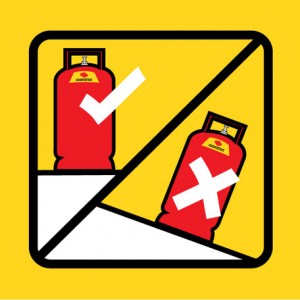LPG Safety Measures At Home
LPG is a colourless liquid that evaporates into a gas. It has no smell, but does have an odour added to help detect leaks. It can burn or explode when it mixes with air in the right proportions and finds an ignition source. It is heavier than air. It can flow for long distances along the ground, and can collect in drains, gullies and cellars. Incorrect use of LPG can result in explosions, fires, lost of property and most importantly, loss of lives. Do not neglect issues like leaking gas cylinders or tubes, damaged regulators, incorrect method of storage of LPG cylinders, etc.
Know the symptoms of carbon monoxide poisoning - it could save your life:
headaches
dizziness
nausea
breathlessness
collapse or loss of consciousness
symptoms which disappear or get better when you leave home and come back when you return
other people (and animals) experiencing the same symptoms at the same time
Know what to do if you suspect carbon monoxide poisoning:
get fresh air immediately - open the doors and windows
turn off any gas appliances and turn the gas off at the meter
extinguish naked flames
leave the house
see your doctor immediately or go to hospital - let them know that you suspect carbon monoxide poisoning
call the Gas Emergency Helpline if you think there's any danger
What are the points to remember about the rubber tubing?
It must be of approved quality, (ISI mark).
It should be as short as possible. Maximum length should be about 1.5 meters.
It should be easily accessible for inspection.
Keep it away from heat and fire.
Push it so as to cover the full length of the nozzle.
Make sure it does not get heated by the burner, or is looped/twisted.
Clean it with wet cloth only. Don't use soap to ease the tube over the nozzle.
Check it regularly for cracks, holes, softness, and porosity especially at the ends.
Replace tubing every 2 years if not earlier.
Do not cover rubber tubing by any other object or sleeve.
The Pressure Regulator is very important too.
It is connected to the outlet of the cylinder valve. its function is to regulate the pressure of the gas coming out of the cylinder and supply it at a constant pressure to the hot plate.
If you smell gas
Disconnecting the empty cylinder
Connecting the filled Cylinder
To light the burners
Safety goes a long way
Good habits for your safety
If you smell LPG inside your home
Keep flames and cigarettes out of the affected room and away from the area.
Turn off all gas appliances.
Turn off the gas supply at the LPG cylinder(s).
Open doors and windows to ventilate the area.
Leave electrical appliances or switches as they are - a flick on or off can cause a spark.
Don�t use a mobile phone in the area.
Contact your LPG retailer or a licensed gas worker immediately to check the installation.
If the smell persists in the house go outside to a safe place away from the building.
�
Disconnecting the empty cylinder
Put out all the flames and fires including incense sticks, candle, pooja lamp in the kitchen and adjoining rooms
Close all the taps on the cooking stove
Turn the switch knob of the regulator from ON position to OFF position
Grip the regulator and pull the bush (black plastic locking ring) up and lift the regulator by giving a gentle swivel. Regulator will thus get detached from the valve on the cylinder
Place the delrin (plastic) safety cap on the valve of the cylinder. Press the cap firmly down until a distinct click is heard. Now the empty cylinder can be removed
�
Connecting the filled Cylinder
To remove the safety cap, press it down, PULL the cord and keeping it pulled, LIFT the cap off the valve of the cylinder.
Check whether sealing ring is in place inside the cylinder valve by feeling the same with the help of your little finger. Do not use the cylinder if the ring is missing, put back the safety cap and contact your distributor for replacement of cylinder.
To mount the regulator on the filled cylinder, carry out the following steps:
Ensure the switch knob of the regulator is in the OFF position
Grip the regulator and pull up the plastic blush
Place the regulator vertically on the valve and press it down till its edge touches the hexagon of the valve on the cylinder with a gentle swivel. Release the black plastic bush and then press it down.(you may hear click sound)
The pressure regulator is now locked on the cylinder.
To light the burners
Turn the switch knob of the regulator anti - clockwise till it is in ON position Hold a lighted matchstick near the burner head of the stove and turn the knob of the stove to ON position
Safety goes a long way
Do not wear nylon garments or similar fabric when cooking
Never leave the cooking appliance unattended when in use
Never try to Repair, Adjust or Inspect any part of the HP Gas Installation or allow fake mechanics to do so.Allow authorized mechanic to inspect the installation once in two years
Do not use long curtains on windows if your cooking appliance is near it. They can blow over the burner and catch fire
Insist on redelivery check of the refill cylinder at the time of its delivery
Do not install the cooking appliance on the floor. Do not use a wooden table without asbestos sheet over it
LPG Gas should never be used in a poorly ventilated room
Never install a Gas cylinder below ground level or in cellars or basements
No other heating device (Like an electric oven or a kerosene stove) should be placed within one meter of Gas appliance
Do not use any cover on the rubber tube, rubber tube T joint connection or trolley for cylinder in your� Gas installation
Never leave the regulator in ON position after cooking is over or during night
Always smell for leakage of LPG before lighting the stove
Never use the rubber tube if it has cracks or is more than 2 years old
Good habits for your safety
The place where you install your gas installation is very important. If the following precautions are taken, it will by itself be an insurance against any mishaps occurring in your kitchen.
Always keep the cylinders in a vertical position with the valve on top. If cylinder is placed in any other position, liquid LPG may gush out of the open valve creating a dangerous situation.
Cylinders must be installed at ground level and never below ground level or in cellars or basements etc.
Not more than two cylinders should be stored in a room. To keep two cylinders, the kitchen should have minimum floor area of 10 sq. meters.
If cylinders are placed in cupboards, these cupboards should be provided with ventilation openings both at floor level and at top level. A half gap should suffice.
Cylinders must not be installed in any position in which they may become overheated, e.g. alongside a sigree or any other heating appliance. If any heating appliance has to be used, it must be kept at above ground height and never on floor level.
Avoid storing combustible articles close to cylinder and LPG installation.
No other heating device such as an electric oven, kerosene stove, etc, should be placed within a metre of your gas appliance.
Do not keep cylinder exposed to sun, rain, dust and heat.
Do not keep any vessel / utensil / cloth etc. on the top of cylinder.
Always keep the safety / security cap tied with the top ring stay plate, so that in the event of leakage through valve spindle the cap can be fixed on the top of valve for stopping the escape of gas.
The installation should be kept at convenient place so that cylinder, Pressure Regulators knob and rubber tube is easily accessible.
Do not keep empty or full cylinders without cap fitted on the valve.
For operating the pressure regulator always follow the instruction given at the top sign plate of pressure regulators.
Always use BIS approved rubber tube, check for BIS mark on the rubber tube. The length of tube should be between 1 to 1.5 mtrs. Please ensure that rubber tube is replaced after 24 months of use.
Dont conceal any part of rubber tube by any type of shut or cover, which obstructs the visual check along the total length of tube.
Always use BIS marked hot plate/ appliances.
Avoid keeping pooja lamp and Refrigerator in Kitchen.
Get your cylinder checked by deliveryman at the time of receipt of refill.
Do not install the cooking appliance on the floor. The appliance should always be on a table or slab placed at a convenient height so that cooking is possible in a standing position. Do not use a wooden top table. If the table is of wood, use an asbestos sheet on the table and place the stove on top of it.
Do not place the appliance directly in front of the window. There is a chance that a strong breeze may put off the flame causing accumulation of LPG in the room.
The appliance should be on a table or slab with one side touching a plain wall. The backside of your appliance should be facing towards this wall. There should be no shelves or spoon racks on this wall. There is a possibility that your apparel may catch fire leaning over a lighted stove to retrive something placed or store on this wall.
The room/ kitchen where LPG is used should be well ventilated and should have cross - ventilation. LPG should never be used in a room with windows and doors shut.
Ensure that the nozzle of your appliance is of the same dimensions as the nozzle of your regulator and rubber tubing of the correct bore is used. Your dealer will advise you of the dimensions
The appliance must be at least one metre away from electric wiring, switch or plug points. Keep the kitchen clean as far as practicable to avoid rats, cockroaches etc.










